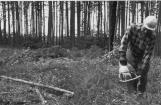1
The chain saw was arguably the most influential piece of equipment introduced to the logging industry with regards to raising the man-day productivity of loggers. Prior to the chain saw loggers used "Sewed" or buck saws to cut and de-limb the trees to the desired length.3
It was not until 1937 that the Canadian market created a demand for chainsaws in the West. A German inventor / manufacturer by the name of Andreas Stihl drove across Canada attempting to sell his 160-pound chain saw. He had little success until he reached western Canada where fellers immediately recognized its potential. But, with the onset of the Second World War importation of German machinery including the "Hitler" saw was curtailed. Therefore in 1939, Canadians filled the void creating their own models of chainsaws. In 1947, the lighter chainsaw started making inroads into the smaller timber markets of Eastern Canada. Eastern loggers could choose from one of two styles both weighing in at 50 pounds or more; the "bow saw" and the "beavertail". The bowsaw is rarely seen now, but the beavertail is still around.The components of the chain saw have had constant improvement until the mid 1960s, since then few changes have been made to the chain saw. The "scratch" chain was first developed and patented in 1919, used the knife-tip principle to cut through the wood fiber, like a buck saw tooth, only attached to a flexible sprocket chain. This type of cutting was used until 1952 before being re-engineered to its present "chipper" style which uses more of a chisel cutting action.
5
Early Canadian saws used a manual clutch, which was very aggravating because it caused the saw to stall at low RPMs or when the chain pinched in the cut. Stihl had a centrifugal clutch in Germany in the late 1930's, but it did not become available in North America until about 1953, when it replaced the manual clutch. Another quantum leap forward was the elimination of the transmission drive. IEL Pioneer was probably the first to introduce the very fast-moving direct drive mechanism.The direct drive (faster chains) allowed loggers to de-limb trees with their chain saws, virtually eliminating the axe from the forest. Many serious injuries and fatalities resulted from kickbacks, misjudgment and carelessness. Various styles of safety chains (safer chains) were introduced during the late fifties and through the sixties. Safety training and hazard-awareness did a lot to reduce injuries, as did gradual weight-reduction as newer, lighter materials were used in the manufacture of chainsaws. The chain brake, another great safety feature to deal with kick-back injuries, was added in about 1975 and legislation was soon introduced demanding that all chainsaws be so equipped.



